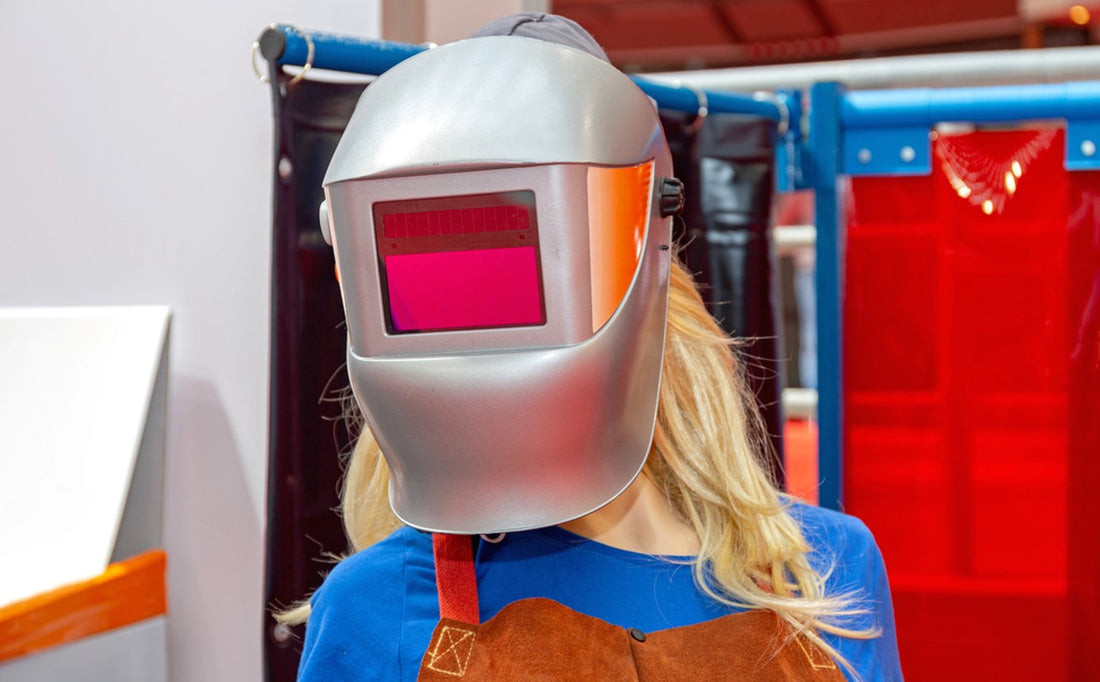Auto-darkening helmets are a type of welding helmet that can be an indispensable tool in a welder’s toolkit. In essence, they prevent welders from having to flip the lens of their helmet on and off. They are similar to having sunglasses in bright daylight. Auto-darkening helmets use Shade 3 filters.

How Do They Work?
These particular types of helmets work by using a shade filter corresponding with the arcs of light present during a welding project. Their sensors pick up on light from the arc, which activates a filter – usually made of liquid crystal – which then “fires up” a preselected shade or tint.
This shade protects the worker’s face and eyes from UV/IR radiation. Auto-darkening helmets use solar cells to capture intense light from the welding arc. These cells create a robust electric signal for the lens shade to darken within a fraction of a second.
Components of Auto-Darkening Helmets
There are several components that make up an auto-darkening helmet.
UV/IR Filter
One of the principal components of auto-darkening helmets is the UV/IR filter. As indicated above, the helmet's purpose is to block UV/IR radiation exposure. What’s incredibly fantastic about these helmets is that even when the welding lens isn’t activated, the filter still blocks out UV/IR light.
Within the UV/IR filter are five silver layers and six aluminum oxide layers. The UV/IR filter works with the metallic layers and polarization layers to block UV ray exposure.
Polarization Filter
This brings us to the polarization layer or filter. There are three of these filters in an auto-darkening helmet. Combined, they work synergistically to block UV light rays. One of the polarization filters is oriented at a 90° angle. This is because the helmet will reach its maximum darkness at this angle.
Liquid Crystal Cells
These lie between the polarization filters. There are two of them. Electric signals cause them to bend light.
Arc/Light Sensors
These two sensors ensure that the filter's shade matches the light intensity—a critical feature.
Benefits and Drawbacks of Auto-Darkening Helmets
The list of benefits to using auto-darkening welding helmets vastly outweighs the list of cons; however, we feel it imperative to mention all angles here, so take a look at our table below:
|
Pros |
Cons |
|
Easy to use |
Battery power may be an issue. You must constantly check to ensure the helmet has enough juice. |
|
Improved optical clarity |
Can be heavy and clunky |
|
Offers UV/IR protection even when the filter isn’t active and the shade isn’t on |
Cost associated with everything. The helmet itself is expensive, repairs are expensive, and maintenance is expensive. Additional features are also pricey. |
|
Augments functionality, so you don’t have to flip open and close the lens constantly |
|
|
Provides superior protection to the face and neck |
|
|
Personal control over the shade level |
|
|
You can use it in virtually any welding position |
|
|
Improves torch and arc control |
|

Factors to Consider When Choosing an Auto-Darkening Helmet
Viewing Area
Optimal viewing area maximizes productivity when using the helmet. This means you need a sufficient area to view your welding project. The helmet should maximize this coverage with little to no effort. Basically, choose a helmet with the maximum coverage area.
Controls
You can situate your helmet controls either inside or outside your helmet. These controls will allow you to adjust features like light sensitivity and most of the other functions of the helmet.
Light Sensitivity
A chief consideration here is light sensitivity, as that’s what your helmet is designed to adjust for. The helmet won’t serve its intended purpose unless the light sensor is fully functional, so make sure they are!
Sensitivity Controls
As mentioned above, you don’t have to adjust the lens of the auto-darkening helmet manually. Its purpose is almost “smart” – it auto-adjusts, auto-corrects, auto-does everything. That said, each individual is different and has a different sensitivity to light. Adjusting your controls allows for optimal performance of the helmet.
Delay Controls
This is an elegant feature of auto-darkening helmets. The primary function of your helmet’s delay controls is determining how long the lens shade will stay dark after the light arc stops. Adjusting the delay controls properly ensures the welder has time to adjust to the presence or lack of bright light.
Reaction Time of the Lens
This function determines the speed at which the lens transitions from light to dark or functioning to non-functioning. The reaction time should be such a fraction of a second that it’s not noticeable or visible, preferably 1/20,000 of a second or less.
Arc Sensors
Some, but not all auto-darkening welding helmets have only two of these, which will cause the shade darkener to be less functional. We suggest choosing a helmet with at least four arc sensors.
Power Source
There are many different power sources for the various auto-darkening helmets. They include four different types of batteries: lithium, rechargeable, solar-powered, and replaceable.
Comfort and Helmet Weight
With all of these “accouterments,” it’s essential to ensure that the helmet isn’t too unwieldy or uncomfortable to use and manage. Choose helmets that include all the features but go easy on the weight.
Conclusion
Auto-darkening helmets are as helpful as they can get for metal welders. Pick one up and check out the other protective gear at Ecenrode Welding Supply today!

